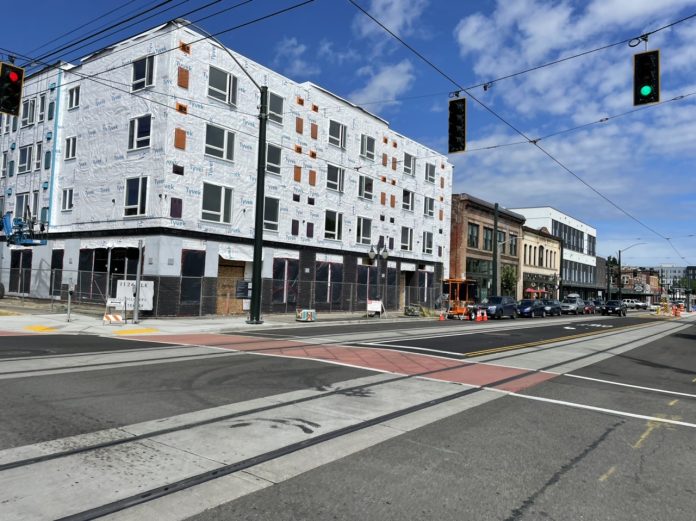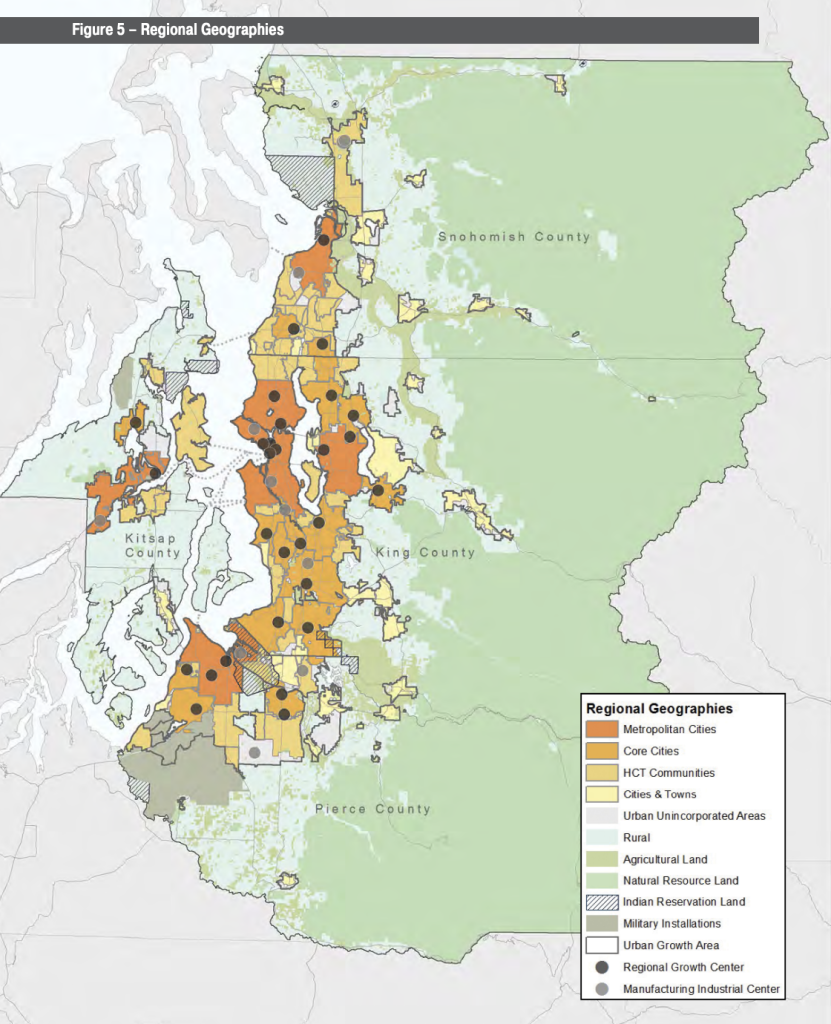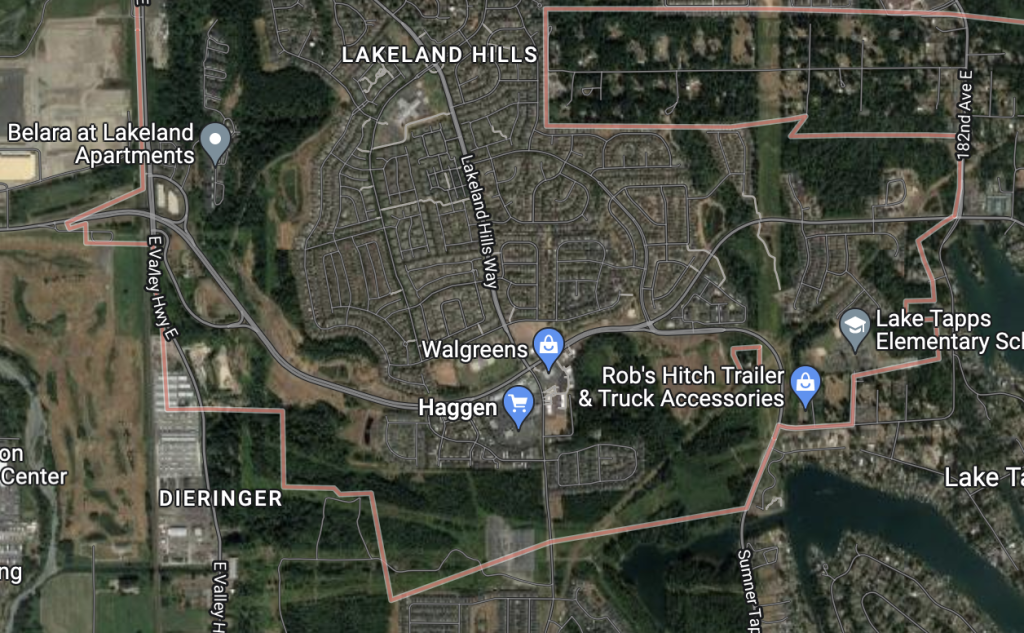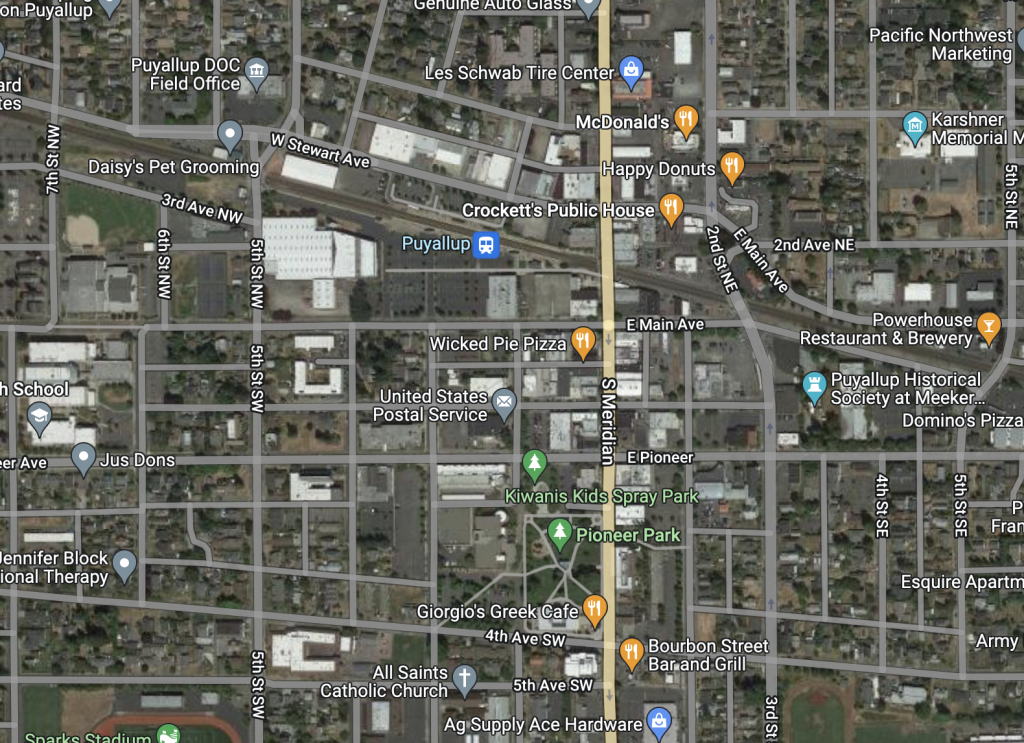
Pierce County is close to allocating its growth targets to local municipalities and unincorporated areas. In total, the county is supposed to accommodate 264,785 more residents and 147,500 jobs by 2044. The growth allocations will then be used by local governments in determining how they update their comprehensive plans, zoning, and development regulations by the end of 2024.
The county has been somewhat slow to settle on growth targets whereas King and Snohomish Counties adopted their growth target allocations last year. Local municipalities have been a thorn in the process, disagreeing particularly on population allocations. Auburn was a particular obstacle to this process by refusing to take on its due share, but it wasn’t the only city to do so.

A group of Core Cities, as designated by the Puget Sound Regional Council (PSRC), initially requested lower growth target allocations than mandated by the PSRC’s regional long-range plan (Vision 2050). The cities only wanted to accommodate 41,914 more residents while the PSRC’s allocations envisioned 60,900 more residents. Various letters by the cities of Lakewood, Puyallup, and University Place explained why they felt lower population allocations were appropriate.
Puyallup’s planning director, Jeffery Wilson, went to great lengths in a letter arguing against full growth allocations. He claimed that the city center — its principal regional growth center — is too historic, packed in, and geologically risky for much redevelopment. Wilson also claimed that modestly rezoning the city’s vast low-density residential areas was fraught with infrastructure constraints.
University Place’s deputy planning director, David Swindale, was insistent that the city should not need to plan for high levels of growth over infrastructure cost concerns and downplaying the significance of growth allocations. “The City Council is inclined to take a conservative approach to planning for population and employment growth, recognizing that there are costs associated with planning for growth that is unlikely to occur,” he wrote. “Growth allocations should not be considered hard numbers, rather estimates based on population and employment forecasts.”
In another letter by Lakewood’s city manager, John Caulfield, argued among other things that the city is a “built-out community” and “not a full-service city,” thus complicating planning coordination between local water, fire, and electricity service providers.
While shades of these concerns may have some merit, the bulk of them overstate the challenges most of these communities face to accommodating growth, which boils down to heavily restrictive zoning across the jurisdictions. Cities that face infrastructural cost issues have the ability to exact various types of compensatory development fees and, if it ever came to it, to impose interim development moratoria to buy time in addressing infrastructure deficiencies.

Nevertheless, what really stands out is Auburn’s almost total lack of population growth targets in Pierce County. Throughout the process, the city held its line that it wouldn’t accommodate more than an additional 263 residents in its Pierce County urban growth area even though Auburn is mostly located in King County where it’s taking on 2,380 more residents in that portion of the city. The other Core Cities eventually relented in May by agreeing to taken on higher levels of growth allocations.
| Core City | Proposed Population Targets (February) | Proposed Population Targets (May) |
| Auburn | 263 | 263 |
| Lakewood | 16,662 | 23,180 |
| Puyallup | 16,995 | 18,495 |
| University Place | 7,994 | 13,892 |
| Total Allocation | 41,914 | 55,830 |
| Total Allocation Deficit | (18,986) | (5,070) |
As noted in the table above, the agreed upon population growth allocations for the Core Cities still came up short by 5,070 additional residents. The Pierce County Regional Council (PCRC) — which is the countywide planning body — settled the issue in June by allocating most of the remaining population deficit to the county’s sole Metropolitan City: Tacoma.
Outside the Core Cities, the growth target allocations don’t appear to have been controversial with cities, towns, and unincorporated county areas taking on their due share envisioned by the Vision 2050 regional long-range plan.
Under Vision 2050, the plan outlined shares of population and job growth by regional geography as follows:
| Regional Geography | Population Share | Population Growth | Job Share | Job Growth |
| Metropolitan Cities | 38% | 101,618 | 48% | 70,800 |
| Core Cities | 23% | 60,900 | 23% | 33,925 |
| High-Capacity Transit Communities | 21% | 55,605 | 15% | 22,125 |
| Cities and Towns | 7% | 18,535 | 6% | 8,850 |
| Urban Unincorporated Areas | 8% | 21,183 | 6% | 8,850 |
| Rural | 3% | 7,944 | 2% | 2,950 |
| Total | 100% | 264,785 | 100% | 147,500 |
Of course, the final recommended population numbers didn’t quite shake out to match the regional plan with notable differences in a few areas:
- The Metropolitan City (Tacoma) is expected to plan for an extra 4,359 residents (105,977 total);
- Unincorporated Urban Areas areas are expected to plan for an extra 10,883 residents (32,066 total); and
- Core Cities area expected to plan for 5,070 fewer residents (55,830 total).
Pierce County attributes the extra population for the Unincorporated Urban Areas to projects that are vested and in the pipeline for development.
There are also some differences in job growth allocations recommended with 6,121 jobs fewer than targeted in Vision 2050. The main contributor to the lower job allocations is Core Cities planning for more modest targets.
The final population, housing, and job growth numbers allocated recommended by the PCRC are as follows:
| Regional Geography | Population Share | Population Growth | Housing Share | Housing Growth | Job Share | Job Growth |
| Metropolitan Cities | 38% | 105,977 | 39% | 42,390 | 50% | 70,800 |
| Core Cities | 20% | 55,830 | 21% | 23,021 | 19% | 27,521 |
| High-Capacity Transit Communities | 20% | 55,605 | 19% | 20,036 | 16% | 22,125 |
| Cities and Towns | 7% | 18,246 | 8% | 8,889 | 7% | 9,133 |
| Urban Unincorporated Areas | 12% | 32,066 | 10% | 10,870 | 6% | 8,850 |
| Rural | 3% | 7,944 | 2% | 2,605 | 2% | 2,950 |
| Total | 100% | 275,668 | 100% | 107,821 | 100% | 141,379 |
Breaking this down by city and unincorporated area, the targets shake out as follows:
| Jurisdiction | Population | Housing | Jobs |
| Auburn | 263 | 96 | 0 |
| Bonney Lake | 3,591 | 2,850 | 1,717 |
| Buckley | 3,121 | 1,374 | 1,080 |
| Carbonado | 64 | 17 | 6 |
| DuPont | 5,184 | 1,960 | 1,177 |
| Eatonville | 794 | 277 | 152 |
| Edgewood | 5,931 | 2,432 | 1,962 |
| Fife | 4,402 | 1,873 | 5,077 |
| Fircrest | 1,910 | 788 | 113 |
| Gig Harbor | 2,200 | 1,000 | 2,747 |
| Lakewood | 23,180 | 9,714 | 9,863 |
| Milton | 600 | 259 | 441 |
| Orting | 549 | 168 | 196 |
| Pacific | 0 | 0 | 638 |
| Puyallup | 18,495 | 7,488 | 14,715 |
| Roy | 253 | 95 | 92 |
| Ruston | 453 | 169 | 71 |
| South Prairie | 39 | 13 | 10 |
| Steilacoom | 464 | 176 | 10 |
| Sumner | 4,904 | 2,035 | 5,313 |
| Tacoma | 105,977 | 42,390 | 70,800 |
| University Place | 13,892 | 5,723 | 2,943 |
| Wilkeson | 187 | 69 | 11 |
| Unincorporated Pierce County (Urban) | 71,271 | 24,250 | 19,295 |
| Unincorporated Pierce County (Rural) | 7,944 | 2,605 | 2,950 |
On balance, Pierce County will plan for 10,883 more residents but 6,121 fewer jobs than Vision 2050 contemplated. Over-planning population and housing isn’t a problem, but undershooting population and job growth in Core Cities might be. What consequences that could follow for this under Vision 2050 remains unclear, but it does signal that Pierce County is willing to kowtow to suburban interests in quashing housing opportunities where they might be useful. On the flip side, the county is still planning for the targeted level of population and housing that the PSRC thinks the county needs, which ultimately means more development in Tacoma where services, amenities, and jobs are abundant and where development is more environmentally sustainable.
The Pierce County Council will consider legislation adopting the final county growth allocations on August 16th. While it’s possible further changes to growth allocations could be pursued by the county council, it’s unlikely that the body would make consequential changes since most local governments have already agreed to the growth allocations. Once the growth allocations are adopted, cities and towns across Pierce County will move ahead with their comprehensive plan updates with definite population, housing, and job goals. Additionally, Pierce County’s low rural housing and population targets are going to be an interesting thing to watch as the county develops policies to reduce the pace of housing growth to no more than 108 homes per year — a pace of growth far lower than has been experienced in the past decade. How this all shakes out will be something to follow closely.
Stephen is a professional urban planner in Puget Sound with a passion for sustainable, livable, and diverse cities. He is especially interested in how policies, regulations, and programs can promote positive outcomes for communities. With stints in great cities like Bellingham and Cork, Stephen currently lives in Seattle. He primarily covers land use and transportation issues and has been with The Urbanist since 2014.


